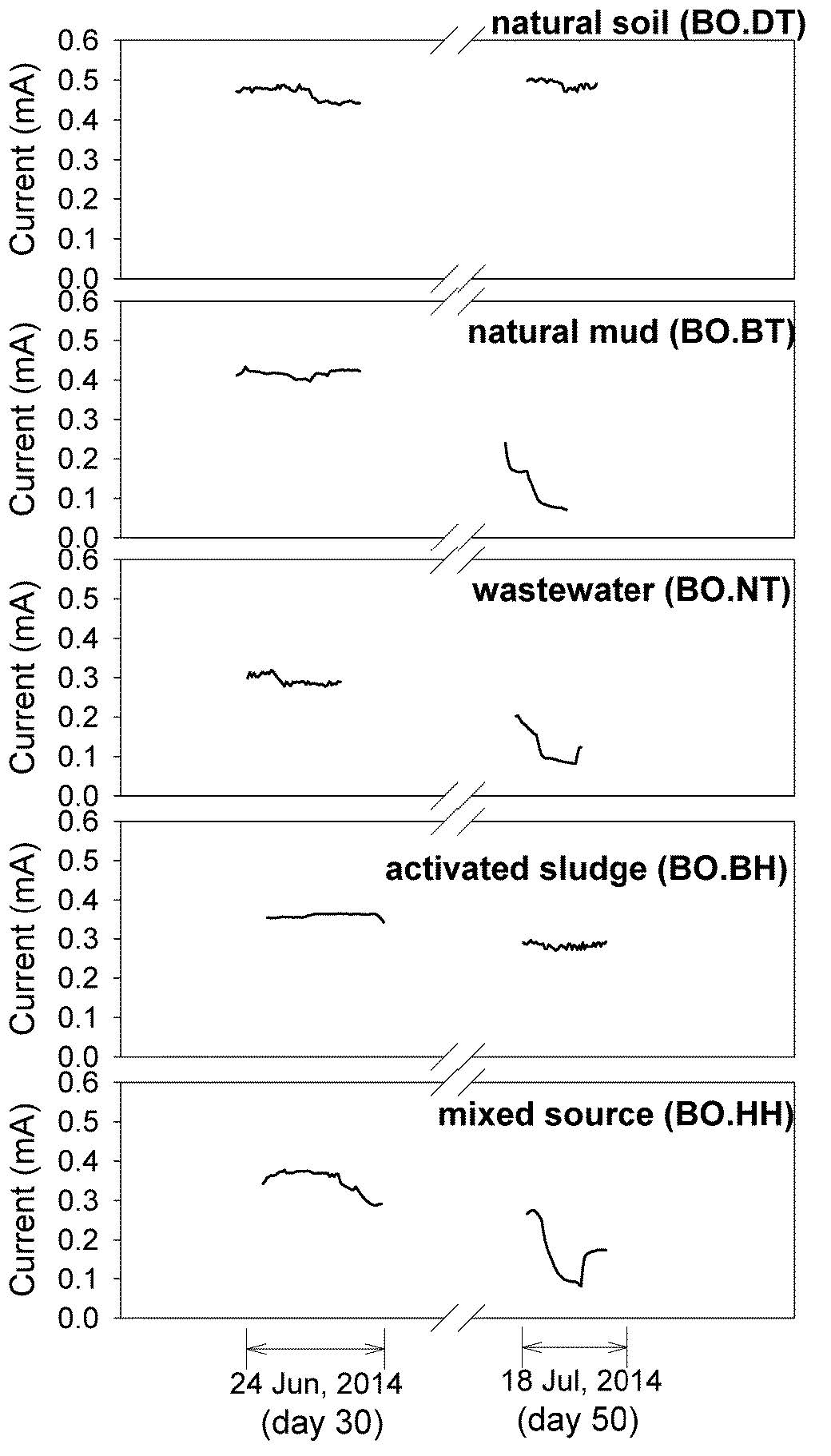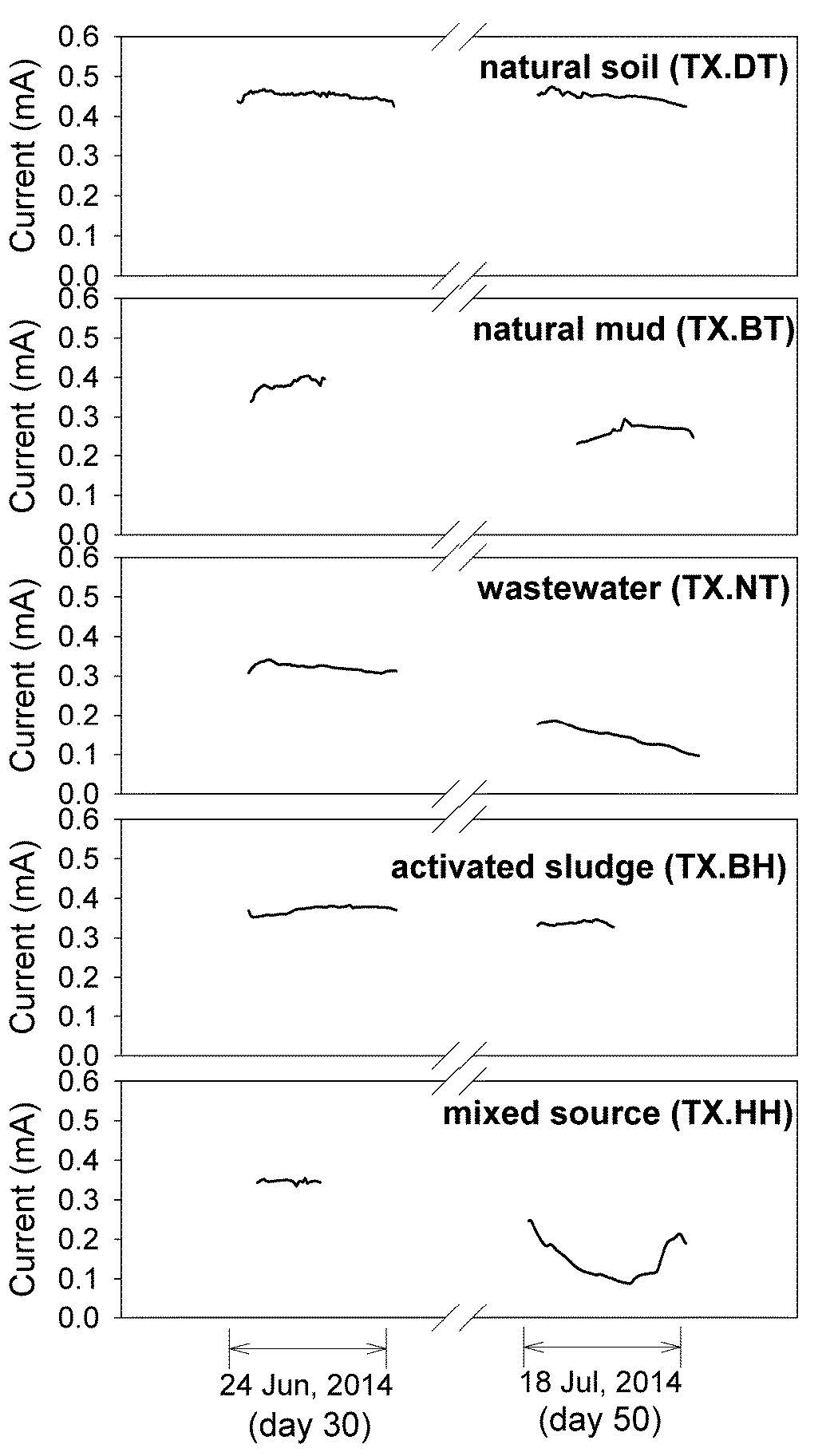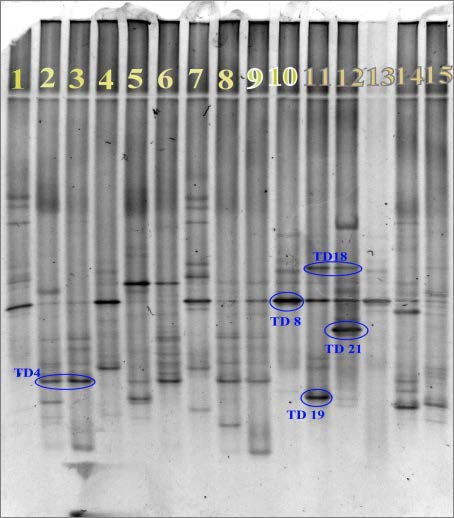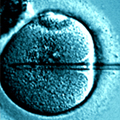List of abbreviations: MFC: microbial fuel cell, BOD: biological oxygen demand, DGGE: denaturing gradient gel electrophoresis, EAB: electrochemically active bacteria, BO: BOD sensor type; TX: toxicity sensor type, DT: a natural soil sample, BT: a natural mud sample, BH: an activated sludge sample, NT: a beer-producing wastewater sample, HH: a mixture of all the mentioned samples.
1. Introduction
Microbial fuel cell (MFC) technology has emerged considerably in recent years. A MFC is a device that converts chemical energy into electrical energy through catalytic reactions of electrochemically active bacteria(EAB) [1]. Due to unique properties, MFCs can be applied for producing electricity and/or useful materials, for wastewater treatment and or particularly for use as a sensor to analyze pollutants [2,3].
The use of MFCs as sensors, such as lactate sensor or BOD sensor, was proposed a long time ago [4,5]. Indeed, for practical applications, several kinds of MFC-typed BOD sensors have been developed [6,7,8]. Besides, several studies have shown that MFCs can be also applied as toxicity sensors due to the fact that electricity generation in a MFC can be affected by toxic compounds in wastewater [9]. Conventional methods for the assessment of quality of wastewater have been widely applied but have several limitations. The standard 5-day biochemical oxygen demand method (BOD5), adopted by American Public Health Association Standard Methods Committee in 1936 for analyzing the BOD value of wastewater, is time-consuming (taking 5 days) and needs to be carried out by experienced technicians. On the other hand, the methods for analyzing toxic compounds in water, such as HPLC (High-performance liquid chromatography); GC-MS (Gas chromatography-mass spectrometry), etc. are in general costly and also time-consuming. Recent studies have been concentrating on developing biological methods to monitor wastewater quality, using living organisms such as fish, daphnia, or algae. However, these methods have some drawbacks such as long detection time, low sensitivity, complication in data interpretation and difficulties in maintaining the organisms in a well-responding form [10,11]. Thus, researchers have changed the focus to the use of microorganisms as these tiny organisms have high metabolic rates and short generation times, and can respond very quickly to any change in the environment. Particularly, MFCs appear to have characteristics suitable for use as a biosensor monitoring the quality of wastewater, including real-time monitoring, spontaneous response, rapid warning, easy operation, easy interpretation of data, and longer usage.
The operation of a MFC depends on a range of parameters, which should be optimized in order to ensure a good performance of the devices, particularly as biosensors. As biosensors, the electrical signals generated by MFCs are required to be not only well-responding but also stable over time. Among the parameters affecting the operation of a MFC, the bacterial consortium in the anode is one important factor. The relationship between the composition of anode community and its performance has been researched earlier [12,13]. In previous studies, it was revealed that the well-performing bacterial communities contained typical electrochemically active species, such as Shewanella sp., Geobacter sp. or Pseudomonas spp. [14]. Particularly, Pseudomonas spp. were found dominant in some continuously-operated systems and believed to play a key role in producing electron shuttles at the anodes [15]. A question is whether the original inoculum might affect the final working community in the anode compartment and subsequently affects the operation of a MFC. If so, a proper source of bacteria should be selected for each MFC, and time for enrichment as well as optimization of the MFC can be shortened. Up to now, there still have been no certain studies researching on which microbial source leads to a better performance of sensor-typed MFCs. There have been some studies on the effect of inocula on the performance of MFCs but the inocula were either acclimatized with substrates or the range of inocula tested was narrow, focusing only on predictably suitable ones such as those reducing metals [16,17,18]. Therefore, we carried out this comprehensive study, in which we enriched anode communities from 5 different microbial sources, and examined their impacts on the performance of the sensor-typed MFCs as well as analyzed the composition of the working bacterial communities after enrichment.
2. Materials and Method
2.1. Microbial sources
In this study, we used five different sources of bacteria as inocula for the MFCs, including: (i) natural soil (DT) that is a mixture of soil samples collected from the Fansipang mountain in Lao Cai province, Cuc Phuong national park and Van Long lagoon in Ninh Binh province; (ii) natural mud (BT) that is a mixture of mud samples from Van Long lagoon in Ninh Binh province and Xuan Thuy national park in Nam Dinh province; (iii) activated sludge (BH) that is a mixture of anaerobic and aerobic sludge from wastewater treatment plants of Hanoi beer company in Hung Yen province; (iv) a mixture of wastewater and sewage sludge (NT) from typical industrial villages in northern Vietnam such as Phong Khe paper-manufacturing village, Dan Hoi metal recycling village and Hoi Quan textile staining village in Bac Ninh province; (v) a mixed source (HH) that is the mixture of the four above-mentioned sources. All sampling locations are in Vietnam. The samples were collected following standard procedures recommended by the US Environmental Protection Agency. After collected, the samples were stored at 4 oC.
2.2. MFC design and operation
Our MFCs were constructed following the design proposed by Kim et al. (2003) [5]. Each MFC used in the study was constructed by using two poly acrylic plastic plates (50 × 90 × 20 mm3), sandwiched by two thinner polyacrylic plastic plates, one of which (50 × 90 × H mm3) was carved in the middle to form the anode chamber (10 × 50 × H mm3) with H equals 10 or 15 mm depending on the type of MFC to be tested, and the other (50 × 90 × 15 mm3) carved to form the cathode chamber (10 × 50 × 15 mm3). A Nafion 117 membrane (DuPont Corp., USA) was used for separating the anolyte and the catholyte. Between any two adjacent plates, a rubber sheet (50 × 90 × 2 mm3) was placed and each system was assembled using nuts and bolts to ensure the system is air-tight. Graphite felt was used as the electrode material (with the size of 9 × 45 × 5 mm3 for each electrode, i.e. anode or cathode). Such an electrode was connected to a graphite rod (having a diameter of 6 mm) by using epoxy glue mixed with graphite powder to ensure that their final resistance did not exceed 2 Ω/ cm. Electrical wires (with a diameter of 1 mm) were used for connecting graphite rod and an external resistor of 10 Ω.
In this study, we tested two types of MFCs: The first type (toxicity sensor type or TX) with the thickness of the anode chamber being 10 mm (H = 10) was designed for the detection of toxic chemicals; the second type (BOD sensor type or BO) with the thickness of the anode chamber being 15 mm (H = 15) was designed for BOD monitoring.
Each of those sensor typed MFC reactors was operated continuously at room temperature. The anodic compartment was continuously supplied with modified artificial wastewater that is based on a minimal medium supplemented with glucose and glutamate [6]. The minimal medium contained 0.56 g (NH4)2SO4, 0.42 g NaHCO3, 0.114 g KH2PO4.3H2O, 0.068 g K2HPO4, 0.0247 g MnCl2 and 10 ml of a trace solution per liter [6]. The trace solution contained 1.1 g FeSO4.7H2O, 0.1 g MnCl2.4H2O, 0.17 g CoCl2.6H2O, 0.1 g ZnCl2; 0.1 g CaCl2.2H2O, 0.002 g CuCl2.2H2O, 0.001 g H3BO3, 0.001 g Na2MoO3, 1 g NaCl, and 0.13 g NiCl2.6H2O per liter. A solution of glucose and glutamate was added to the sterilized minimal medium contained in a bottle before it was supplied into the anode compartment through a plastic tube. The volume of the glucose-glutamate solution added was calculated to reach the final BOD concentration of the artificial wastewater as desired (30 ppm) [19]. The flow rate of the anode influent was manually adjusted by a dropper to approximately 0.3 ml/min. The cathode compartment contained air-saturated tap-water that was continuously renewed using a circular pump (model Boyu FP 2000, China) from a tap-water tank which was aerated by an air pump (model Heibao Aquarium HB-248A, China) and replaced daily. The tap water was from a storage tank of the laboratory building and thus its chlorine concentration is negligible to have any side effect.
2.3. Electrical measurement and data analysis.
The voltage between the anode and the cathode of each MFC was recorded every 10 minutes by a Extech MN35 multimeter (Extech, USA) or by a digital voltammeter (Keithley Instrument, USA) linked to a multichannel scanner (Keithley Instrument, USA). The corresponding current was calculated according to the Ohm’s law. Collected data were statistically analyzed using standard methods.
2.4. Enrichment process.
A same procedure for the inoculation and enrichment of the anode bacterial consortia in all the MFCs was applied, as following: In the first 14 days, an inoculum was daily supplemented into the anode compartment of each MFC that was operated with modified artificial wastewater containing 30 mg/L BOD and the anode flow rate was 0.3 ml/min. After day 14, the MFCs were operated without the supplementation of inocula. When the generated current reached a steady state, samples from the anolytes and 1 × 1 cm2 pieces of graphite felt were taken and preserved in 1.5 mL eppendorf tubes at −20 oC for molecular analyses.
Each MFC was assigned with a name that includes a first part indicating the type of the MFC, with BO standing for BOD sensor type and TX for toxicity sensor type, and the second part (separated from the first part by a dot) indicating the type of the microbial source used for enrichment, with DT standing for the natural soil, BT for the natural mud, BH for the activated sludge, NT for the wastewater and HH for the mixed source.
2.5. Molecular analyses
DNA extraction: Each eppendorf tube containing a sample was centrifuged at 8000 rpm, 20oC for 10 min. Then, the supernatant was removed and the pellet was mixed with 0.5 mL of sterile deionized water. Total DNA was extracted from the treated pellet, following standard methods [20].
Amplification of 16S rRNA genes: The extracted 16S rRNA gene fragments were amplified using polymerase chain reaction (PCR) with the forward primer P63F (5'CAGGCCTAACACATGCAAGTC3') and the reverse primer P1378R (5'CGGTGTGTACAAGGCCCGGGAACG3') [21], which were provided by Integrated DNA Technologies - IDT (Singapore). The PCR products amplified with the 2 above-mentioned primers were used as the templates for another PCR with P338F (5'ACTCCTACGGGAGGCAGCAG3') as the forward primer and P518R (5'ATTACCGCGGCTGCTGG3') as the reverse primer (Integrated DNA Technologies - IDT) to amplify 200bp fragments [21].
Denaturing gradient gel electrophoresis (DGGE): The amplified 200 bp fragments were used for DGGE with a denaturant gradient ranging from 45 to 60% [22] to investigate the composition of microbial consortia in source samples and the anode samples of the enriched MFCs. The DGGE patterns were analyzed using the software NTSYSpc2.0 (Exeter Software, USA) based on homology matrix and cluster analyses.
The DGGE gel pieces containing remarkable bands were cut off from the gel by a sterile razor and subsequently suspended in 50 µL deionized water and finally stored at 4 oC for 24 hours to allow DNA elution. The eluted DNA was used as the template to amplify the DNA fragment corresponding to each band by PCR reaction with P338F and P518F primer. The PCR products were purified with ExoSAP- IT kit (Affymetrix, USA) and then submitted to Integrated ADN Technologies IDT (Singapore) for DNA sequencing. Homology analyses of the DNA sequences were carried out using the BLAST algorithm and the sequence database in the BLAST server of the National Center for Biotechnology Information (NCBI) [23].
3. Results.
3.1. The generation of electricity by the MFCs — An indication of the enrichment of electrochemically active bacteria.
Several MFC reactors of two types, including the toxicity sensor type (TX) and the BOD sensor type (BO), were set up. These MFCs were enriched with the inocula that were 5 different microbial sources as mentioned and operated with modified artificial wastewater containing 30ppm BOD. Electrical currents could be generated by the MFCs in the first day of inoculation, although at low levels (ca. 0.1-0.2 mA) (Figure 1). This implied that electrochemically active bacteria were present in original microbial sources. The currents fluctuated within the first two weeks of enrichment, especially in MFCs inoculated with the natural soil source. After day 15, although the anode compartments were only supplied with the artificial wastewater, the currents still increased gradually and reached a steady state (0.4-0.6 mA), indicating the successful enrichment of bacterial consortia bearing electrochemical activity from original sources.
3.2. Stability comparison of the currents generated by different MFCs enriched from different microbial sources
It is essential that the MFCs used as biosensors should generate stable currents after the enrichment period. One of the important factors determining the stability of the current generated by a MFC is the enriched bacterial community in the anode compartment.
For BOD sensor typed MFCs, the stability of the currents generated by the MFCs varied, depending on the type of the microbial source used for the enrichment. It was obvious that the electricity generated by the MFCs containing the anode bacteria enriched from the natural soil source (BO.DT), the wastewater source (BO.NT) or the mixed source (BO.HH) reached high values since day 15 of the enrichment (over 0.5 mA); whereas the MFCs with the anode bacteria enriched from the natural mud source (BO.BT) and the activated sludge source (BO.BH) produced less electricity (from slightly over 0.3 mA to 0.4 mA). The bacterial community enriched from the natural soil source performed more effectively than those enriched from other microbial sources. The current generated by BO.DT mostly remained high and stable through the enrichment (0.52 ± 0.03 mA on average). The current generated by BO.NT and BO.HH tended to decrease considerably after day 29.
Moreover, when comparing the currents generated from the BOD sensor typed MFCs at day 30 (i.e. after the enrichment) and day 50, it was noticeable that the MFC with the anode bacteria enrich from the natural soil source still reached a stable current after that 20-day period while the others could not maintain their current levels (Figure 2).
The above-mentioned results demonstrated that the microbial consortia enriched from different microbial sources in the anode compartment had significant influences on the performance of BOD sensor typed MFCs, in terms of both the level and the stability of the electricity generation. It could be realized that the enriched microbial community from the natural soil source was likely to perform more effectively than those from the other sources.
For toxicity sensor typed MFCs, the observed phenomena were more or less similar (Figure 1,Figure 3). The TX.DT and TX.BT MFCs (containing the anode bacteria enriched from the natural soil source and the natural mud source) reached high currents from day 15, which were on average 0.501 ± 0.077 mA and 0.494 ± 0.056 mA, respectively, while the MFCs containing bacteria enriched from the remaining microbial sources generated lower currents. Moreover, the currents generated by the MFCs, except the TX.DT MFC (the soil source MFC), were not stable and decreased gradually in the final period of the enrichment. The current of the TX.DT followed the same trend but finally increased and became stable (Figure 3).
It is therefore obvious that for the toxicity sensor typed MFCs, the bacterial consortia, although enriched from different sources, did not have a very stable performance. However, the soil source TX MFC seemed to display a better performance with stability. The stability of the soil source TX MFC was even more demonstrated by the fact that after the enrichment, the current at day 50 was not significantly different from that at day 30 (Figure 3). The same phenomenon was not observed for the other TX MFCs.
Overall, from all the results above, it could be realized that for both the two types of MFCs, those with the anode bacterial consortia enriched from the natural soil source generated the highest and most stable currents, in comparison with the others.
3.3. Molecular analyses of bacterial communities in the anode of the MFCs
To compare different bacterial consortia enriched from various sources in the anode, we extracted total DNA of bacteria from samples of the original sources (DT, BT, BH, NT, HH) and the anodic electrodes (graphite felt) after enrichment, and then analyzed the transformation of bacterial communities during the enrichment by DGGE.
It can be seen that compared to the original sources, the bacterial communities after the enrichment significantly changed (Figure 4). Especially, between the two consortia enriched from the wastewater source and the mixed source, the similarity coefficients between the working communities and the original communities were 0.64. It is noticeable that the original bacterial communities of the two sources, the natural soil and the natural mud, were highly similar (with the similarity coefficient being 0.94). On the other hand, as shown in Figure 4, some DNA bands of species that are potentially dominant in the source communities became faint or absent in the patterns of the enriched communities. In contrast, some DNA bands that were absent in the patterns of the source communities became bold in the patterns of the enriched communities, indicating the dominance of the corresponding species. These results indicated that the bacterial communities underwent significant changes for adaption in the anode of MFCs. This is a proof that the anodic conditions in each MFC play an important role in enrichment of electrochemically active bacteria from original sources.
The changes in the composition of the bacterial communities in the MFCs at different times were also observed in other studies. For instance, Kim et al. found that in their MFCs, the original communities (anaerobic sludge) used for enrichment and the working communities after 97 days shared a very low degree of similarity (0.1) [24].
DNA sequence analyses of the DGGE bands showed that electrochemically active bacteria were enriched and became dominant in the MFCs, including Geobacter sp. (bands TD 19 and TD 21 in Figure 4); Aeromonas sp.; Shewanella amazonensis; Pseudomonas sp. (bands TD 18 and TD 8 in Figure 4); Geothrix fermentans; Paludibacter sp; Parabacteroides sp.; Tolumonas sp. (band TD 4 in Figure 4); Flavobacterium sp.; Desulfomicrobium sp. These species were also found in MFC systems described before [24,25,26,27,28,29]
As mentioned above, a BOD sensor typed MFC with the anode bacteria enriched from the natural soil source generated high and stable currents. In the DGGE pattern (Figure 4), there was only a bold band (TD8) present in the lane corresponding to the sample from the natural soil source and this band remained bold in the lanes corresponding to the samples from the corresponding communities enriched in MFCs. More interestingly, in the latter, this band even seemed considerably dominant. No similar observation was noticed for the other samples. DNA sequence analyses revealed that the DNA fragment represented by band TD 8 had a sequence highly homologous to that of a 16S rDNA fragment of a Pseudomonas sp. It could be therefore hypothesized that the stable performance of the MFCs enriched from the natural soil source could be related to the dominance of Pseudomonas sp. in the bacterial communities of the MFCs.
4. Discussion.
It should be noted from the results that different MFCs with different anode consortia enriched from different sources showed different performances. For the MFCs with the anode microbes enriched from the sources other than the natural soil source, the currents were either reduced after some time of operation or unstable. This phenomenon is inevitable as MFCs are open systems but the more it is observed, the more strongly it reflects poor and also unstable performances of the corresponding microbial consortia that had been enriched [30]. Variations in performance could also be observed among some MFCs with the anode consortia enriched from a same source, such as from natural mud or from wastewater, or from the mixed source (Figure 1). This also implies that enrichment of EAB from those sources is not consistent and thus cannot lead to an anode community that is stable in function. In contrast, it can be seen clearly that the MFCs containing soil-originated microbial consortia generate more stable currents and thus definitely have better-performing anode communities. From the DGGE patterns, it can be apparently seen that the compositions of the anode bacterial community enriched from soil are particularly different from those of the others.
Our results demonstrated that the enriched bacterial consortia in the anode of MFCs have influences on the level and the stability of electricity generation. According to Kim et al. (2006), the enrichment of electrochemically active communities in MFCs plays a significant role in the function of MFC, especially if these MFCs are not supplemented with mediators. Moreover, the original source for inoculation mainly affects the composition of bacterial consortia, leading to various reactions corresponding to environmental changes in the MFC anode. Ana et al. reported that different microbial consortia enriched from different sources created different internal resistors and contributed differently to electricity generation of MFCs [31]. According to Logan, the composition of electrochemically active bacteria and their growth rate were limiting factors of the performance of MFCs [27,31,32].
From all the above-mentioned results, the differences in the composition among the bacterial communities might account for the differences in the performance among the MFCs. The correlation between the composition of an anode community and its performance has been reported previously [12,13]. Our results indicate that, for a BOD sensor typed MFC, the natural soil is likely a more suitable source for the enrichment of a stable working community, which leads to a good performance of the MFC. It is notable that only Pseudomonas sp. is abundant in the natural soil source and this species also tends to be predominant in the final working community in the MFC after enrichment. Pseudomonas species have been well known as heterotrophic bacteria possessing the ability to flexibly adapt to various environments [33]. Moreover, Pseudomonas sp. is also a type of electrochemically active heterotrophic bacteria that can self-produce electron mediators to reduce an electrode upon oxidizing organic matter [15,34]. Thus, Pseudomonas sp. can easily adapt to the anodic conditions of our MFCs, in a manner more efficient than other species. Moreover, some other dominant species present in the final working communities enriched from the natural soil source probably belong to electrochemically active species such as Geobacter sp.; Shewanella amazonensis … These results lead us to a hypothesis that those electrochemically active bacteria in the MFC inoculated with the natural soil source well harmonize with each other and especially with Pseudomonas sp. and allow Pseudomonas sp. to dominate. Additionally, possibly due to a wide substrate utilization spectrum and a flexible adaptation of Pseudomonas sp., the working community is more balanced than the bacterial communities enriched from other sources [35,36] and thus generates more stable currents.
5. Conclusion
This study demonstrates that microbial sources for inoculation can have significant impacts on the performance of microbial fuel cells. A natural soil source tends to be the proper source for enriching the working community in the anode of BOD sensor typed MFCs. Pseudomonas species were found dominant in the working community enriched from such a natural soil source and definitely played an important role in the better and more stable performance of the corresponding MFCs. Based on our results, it is recommended that various microbial sources should be experimented for the enrichment of the anode bacterial community in a MFC, in order to find out an optimal inoculum resulting in a well-performing community.
Acknowledgement
This research is supported by a grant from Ministry of Industry and Trade in Vietnam (Contract No. 08/HĐ-ĐT.08.14/CNMT).
Conflict of Interest
All authors disclose to have no conflict of interest.









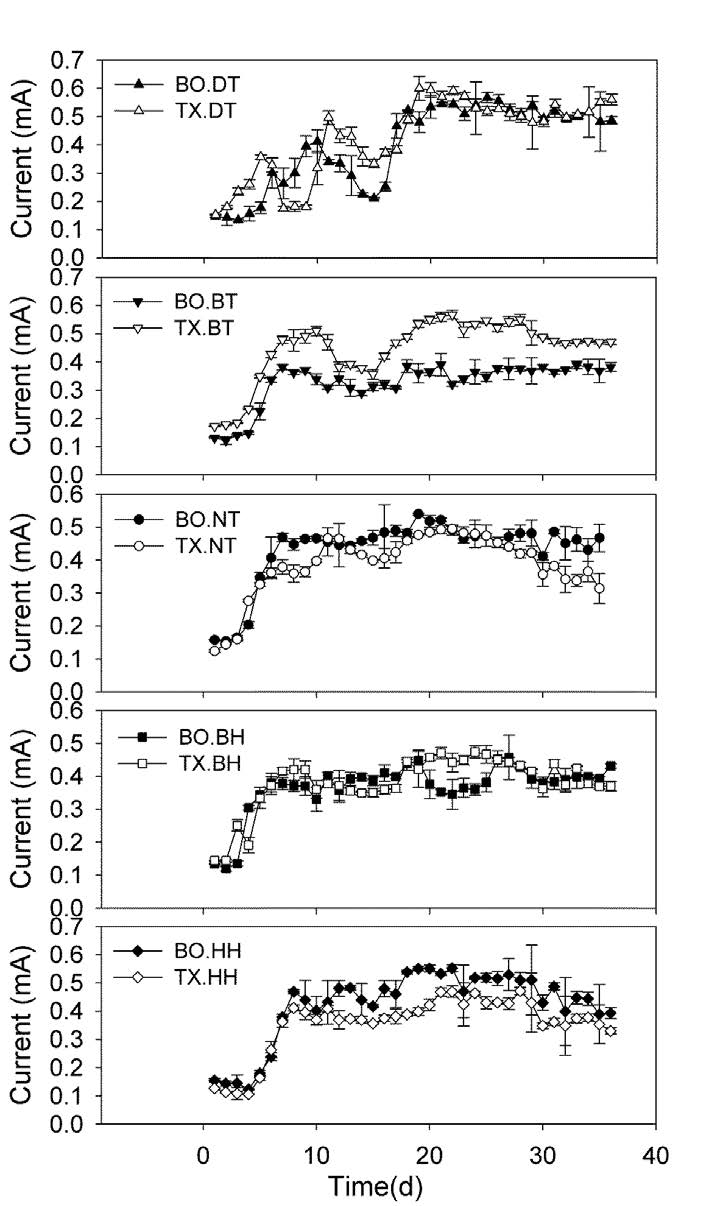
 DownLoad:
DownLoad: 